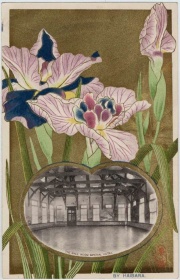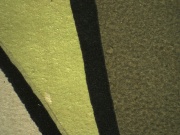Collotype
Description
A photolithographic process commonly used from about 1870 to 1900 for book illustrations. The collotype process was patented in 1855 by Alphonse L. Poitevin in France. The glass printing plate containing a thin layer of bichromated Gelatin is exposed to light under a negative. The gelatin hardens proportional to the amount of light received. The plate is then moistened with glycerin which allows the soft, or nonexposed areas, of gelatin to absorb water. A greasy ink is applied but only retained in the dry regions. The inked image is printed on paper using a printing press. The gelatin on collotype plates wrinkles with drying producing a slight reticulation of the printed image that is detectable with a microscope. Josef Albert introduced rotary collotype presses in 1873 followed by three-color collotypes a year later.
Synonyms and Related Terms
Photopane; Hoeschotype; collotypie (Ned., Fr.); phototypie (Fr.); Lichtdruck (Deut.); Kollotypie (Deut.); Autotype Mechanical Process (Br.); collotipia (It.); colotipía (Esp.); fototipía (Esp.); kollotypi (Sven.); ljustryck (Sven.); Albertotype; Artotype; Heliotype; photogelatine process; ink photo; photocollography
Physical and Chemical Properties
Reticulation, a random pattern of ink wrinkles, is visible with a microscope.
Resources and Citations
- P. Gilmour, "Collotype", The Dictionary of Art, Grove's Dictionaries, Inc. New York, 1996.
- A Glossary of Paper Conservation Terms, Margaret Ellis (ed.), Conservation Center of the Institute of Fine Arts, New York City, 1998
- Encyclopedia Britannica, http://www.britannica.com Comment: "collotype" [Accessed February 28, 2002].
- The Dictionary of Art, Grove's Dictionaries Inc., New York, 1996 Comment: "collotype" by Pat Gilmour
- The American Heritage Dictionary or Encarta, via Microsoft Bookshelf 98, Microsoft Corp., 1998
- Multilingual Glossary for Art Librarians at http://www.ifla.org/VII/s30/pub/mgl.htm

